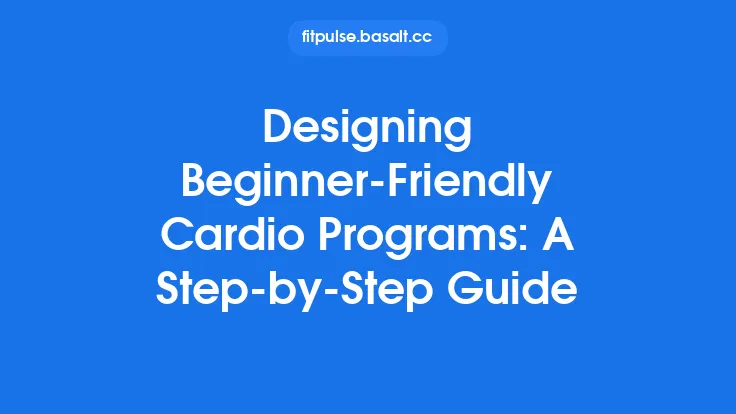Cardiovascular conditioning can feel overwhelming when you’re just starting out, especially with the flood of jargon about “macro‑cycles,” “mesocycles,” and “progressive overload.” The good news is that you don’t need a Ph.D. in exercise science to reap the benefits of a well‑structured cardio program. By applying the core principle of periodization—systematically varying your training variables over time—you can build a solid aerobic base, keep workouts interesting, and avoid the dreaded plateau that stalls progress. Below is a step‑by‑step blueprint designed specifically for beginners, presented in a clear, actionable format that you can start using today.
Why Periodization Matters for Cardio Beginners
Periodization isn’t a fancy buzzword; it’s a practical framework that helps you manage fatigue, optimize adaptation, and maintain motivation. When you repeat the same distance, speed, or time session after session, your body quickly adapts, and improvements slow down. By deliberately altering key variables—frequency (how often you train), duration (how long each session lasts), and intensity (how hard you work)—you continually present a new stimulus for your cardiovascular system to respond to. For beginners, this approach also reduces the risk of overuse injuries because it builds workload gradually and includes built‑in variety.
Step 1: Assess Your Current Cardio Fitness
Before you write any plan, you need a realistic starting point. A simple fitness assessment can be completed in under 30 minutes and provides the data you’ll use to set appropriate training zones.
| Assessment | How to Perform | What It Tells You |
|---|---|---|
| Resting Heart Rate (RHR) | Measure pulse first thing in the morning, before getting out of bed. | Lower RHR generally indicates better aerobic conditioning. |
| Talk Test | During a 5‑minute brisk walk or light jog, try to hold a conversation. | Determines whether you’re in an easy (talkable) or moderate (slightly breathless) intensity zone. |
| 1‑Mile Walk/Run Test | Time how long it takes to cover 1 mile at a steady effort. | Provides a baseline for pacing and can be used to estimate VO₂max with online calculators. |
| Perceived Exertion (RPE) | Use a 0‑10 scale during a short effort (e.g., 5‑minute bike). | Helps you gauge how hard you feel you’re working, useful for self‑regulation. |
Record these numbers in a notebook or a simple spreadsheet. They will serve as reference points for the next steps.
Step 2: Define Clear, Measurable Goals
Goals give direction to your periodized plan. For beginners, keep them SMART (Specific, Measurable, Achievable, Relevant, Time‑bound). Examples:
- Health‑focused: “Walk 30 minutes, 5 days per week, for the next 8 weeks.”
- Performance‑focused: “Complete a 5‑km run in under 35 minutes within 12 weeks.”
- Weight‑management: “Burn an additional 250 calories per cardio session, three times per week, for the next 6 weeks.”
Write your primary goal at the top of your training log. Secondary goals (e.g., “improve RHR by 5 bpm”) can be added later as you progress.
Step 3: Choose the Right Cardio Modality
Beginners often wonder whether to run, bike, swim, or use a machine. The best choice depends on three factors:
- Joint Health & Comfort: Low‑impact options (elliptical, swimming, cycling) are gentler on knees and hips.
- Enjoyment: You’re more likely to stick with an activity you find fun.
- Accessibility: Choose a modality you can perform consistently (e.g., a nearby park for walking, a home treadmill, or a bike that fits your schedule).
You don’t have to limit yourself to one mode; rotating between two or three can add variety and reduce overuse strain.
Step 4: Build a Simple 4‑Week Block Structure
For beginners, a four‑week block provides enough time to notice adaptation while keeping the plan manageable. Each block contains three distinct session types:
| Session Type | Purpose | Typical Duration | Intensity (RPE) |
|---|---|---|---|
| Base (Easy) Day | Build aerobic foundation, promote recovery | 20‑40 min | 3‑4/10 (easy, conversational) |
| Steady‑State (Moderate) Day | Improve cardiovascular efficiency | 30‑45 min | 5‑6/10 (breathier, but sustainable) |
| Challenge (Hard) Day | Stimulate higher‑intensity adaptations | 15‑30 min (intervals or tempo) | 7‑8/10 (hard, but maintainable for short bursts) |
Weekly Layout Example (4‑day week):
- Monday: Base Day
- Wednesday: Steady‑State Day
- Friday: Challenge Day
- Saturday or Sunday: Optional Light Activity (e.g., a leisurely walk)
If you prefer a 3‑day schedule, simply drop the optional light activity. The key is to keep at least one rest day between harder sessions to allow recovery.
Step 5: Gradually Adjust Duration and Intensity
The hallmark of periodization is progressive, yet controlled, change. Within each four‑week block, make small, systematic adjustments:
- Week 1 – Establish Baseline
- Keep duration and intensity exactly at the levels you assessed in Step 1.
- Week 2 – Add 5‑10 % Time
- Increase each session’s duration by 5‑10 % (e.g., a 30‑minute Base Day becomes 33‑34 minutes).
- Week 3 – Slight Intensity Boost
- Raise the RPE by 1 point on the Challenge Day (e.g., from 7 to 8) or add a short interval (e.g., 2 × 1 min at a harder effort).
- Week 4 – Consolidation (Deload Light)
- Reduce duration back to Week 1 levels but keep the intensity slightly higher than Week 1. This “deload” helps cement gains without overtaxing the body.
After completing the block, evaluate your assessment metrics (RHR, talk test, 1‑mile time). If you see improvement, you can repeat the block with slightly larger increments (e.g., 10‑15 % time increase). If progress stalls, consider extending the consolidation week or revisiting your intensity levels.
Step 6: Incorporate Variety to Prevent Plateaus
Even within a beginner framework, variety is essential for continued adaptation and enjoyment. Here are three low‑effort ways to mix things up without overcomplicating the plan:
- Terrain Changes: Swap a flat route for a gentle hill or a treadmill incline for a few minutes.
- Tempo Shifts: On a Steady‑State Day, insert a 2‑minute “pick‑up” segment at a higher effort, then return to easy pace.
- Cross‑Training: Replace one Base Day per month with a different modality (e.g., rowing instead of walking). This challenges the cardiovascular system from a new angle while still respecting the overall workload.
These tweaks keep the stimulus fresh while preserving the core structure of your periodized plan.
Step 7: Track Progress and Make Data‑Driven Tweaks
Consistent tracking is the feedback loop that makes periodization effective. Use a simple log that captures:
- Date & Session Type
- Duration (minutes)
- Average Heart Rate (if you have a monitor)
- RPE (0‑10 scale)
- Notes (e.g., “felt strong,” “knee soreness”)
At the end of each four‑week block, review the log:
- Positive Trends: Lower RHR, faster 1‑mile time, lower RPE for the same duration.
- Red Flags: Persistent high RPE, increasing soreness, or a rising heart rate trend.
If you notice red flags, consider the following adjustments:
| Issue | Quick Fix |
|---|---|
| Elevated RPE on easy days | Reduce duration by 10 % for the next week. |
| Stiffness or minor aches | Add a short mobility routine before/after sessions. |
| No improvement in time/distance | Increase the intensity boost on Challenge Day by another RPE point. |
Common Pitfalls and How to Avoid Them
| Pitfall | Why It Happens | Prevention Strategy |
|---|---|---|
| Jumping straight to high intensity | Excitement or desire for quick results. | Start with the Base Day at a truly easy effort; use the Talk Test to verify. |
| Skipping the consolidation week | Belief that “more is better.” | Treat the fourth week as a built‑in recovery; it’s essential for long‑term gains. |
| Changing the plan every few days | Boredom or fear of monotony. | Use the variety ideas in Step 6 to keep things fresh without overhauling the schedule. |
| Ignoring body signals | Overreliance on numbers alone. | Pair quantitative data with qualitative notes (energy levels, soreness). |
| Setting vague goals | Lack of direction leads to inconsistent effort. | Write SMART goals and revisit them weekly. |
Quick Reference Blueprint (Sample 8‑Week Plan)
| Week | Mon (Base) | Wed (Steady) | Fri (Challenge) | Sat/Sun (Optional Light) |
|---|---|---|---|---|
| 1 | 30 min, RPE 3 | 35 min, RPE 5 | 20 min intervals: 4 × 30 s hard (RPE 7) / 90 s easy | 20‑min walk (RPE 2) |
| 2 | 33 min, RPE 3 | 38 min, RPE 5 | 22 min intervals: 4 × 35 s hard / 85 s easy | 25‑min easy bike |
| 3 | 35 min, RPE 3 | 40 min, RPE 5 | 24 min tempo: 12 min steady (RPE 6) + 2 × 4 min harder (RPE 7) | 30‑min swim |
| 4 | 30 min, RPE 3 | 35 min, RPE 5 | 20 min intervals: 4 × 30 s hard (RPE 7) / 90 s easy | 20‑min walk |
| 5 | 35 min, RPE 3 | 40 min, RPE 5 | 22 min intervals: 5 × 30 s hard (RPE 7) / 80 s easy | 25‑min bike |
| 6 | 38 min, RPE 3 | 43 min, RPE 5 | 24 min tempo: 14 min steady (RPE 6) + 2 × 5 min harder (RPE 7) | 30‑min swim |
| 7 | 40 min, RPE 3 | 45 min, RPE 5 | 26 min intervals: 5 × 35 s hard (RPE 7) / 75 s easy | 35‑min walk |
| 8 | 35 min, RPE 3 | 40 min, RPE 5 | 22 min intervals: 5 × 30 s hard (RPE 7) / 80 s easy | 30‑min bike |
Feel free to swap days to match your personal schedule, but keep the relative order (easy → moderate → hard) to preserve the progressive stimulus.
Final Thoughts
Periodized cardio programming doesn’t have to be a labyrinth of scientific terms and endless spreadsheets. By breaking the process into seven clear steps—assessment, goal setting, modality selection, block construction, gradual progression, variety infusion, and data‑driven tweaking—you create a roadmap that is both actionable and sustainable. The key is consistency: stick with the four‑week block, respect the built‑in consolidation week, and listen to your body’s feedback. Over time, you’ll notice a lower resting heart rate, easier conversations during workouts, and measurable improvements toward your personal goal—whether that’s completing a 5 km run, walking for an hour without fatigue, or simply feeling more energetic throughout the day.
Start today with a quick fitness check, write down a SMART goal, and follow the blueprint above. Your cardiovascular system will thank you, and you’ll build a habit that lasts a lifetime. Happy training!





